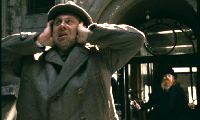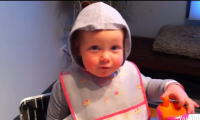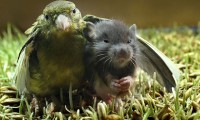Harry Harlow, “Monkey Love Experiments” (1963)
I first saw Dr. Harry Harlow (1905-1981) and his experiments on infant Rhesus monkeys in veteran American experimental filmmaker Ken Jacobs‘ five-decades-in-the-making epic “Star Spangled to Death.” As the title would suggest, Jacobs’ chef d’oeuvre chronicles the horrors of American culture; he does it by approximating an entire day spent watching TV. Entire TV episodes, lengthy movies excerpts, commercials and other mass-media detritus spanning the entire century were stolen and assembled together in a marathon, brain-melting portrait of America as cesspit of pop culture abjection, feeble-minded militarism, and intolerance and violence of every stripe. (By contrast, a suitably hyperactive Jack Smith flounces around as the embodiment of all that is good in the world.)
The half-hour or so of the film featuring Harlow’s monkey experiments remain branded on my brain, long after the rest of Jacobs’ other atrocities have faded from memory. There is something so devastating about Harlow’s quest to quantify that most abstract of qualities: Love.
Much of his research focused on whether an infant monkey would choose a barren but soft cloth mother (“contact comfort”) over a milk-supplying but cold wire mother (sustenance). He found that the monkeys spent much more time with the cloth mothers than with the wires, whom they pretty much visited just to load up on milk: “An instinctive need to cling to another body — soft and warm.” He announces that “[contact comfort] completely overwhelmed and overshadowed all other variables, including those of nursing.” What Harlow sought to measure was this sense of security, his definition of “love.”
Harry Harlow, “Monkey Love Experiments” (1963)
One can’t help but imagine Harlow as a child himself: was his mother wire or cloth? Did she provide him with nutrients but not with hugs? Or just the opposite? I also try to put myself into the place of the infant monkey and imagine what it’s like to live in a tiny cage and cling, terrified, to my inanimate “mother” as the big upright primates torment me day in and day out.
Harlow enjoys himself too much, it strikes us as unprofessional. His intonation is too folksy, his vocabulary cuts too close to the bone in its refusal of jargon. If Wikipedia is to be believed, “Harlow was well known for refusing to use conventional terminology, and instead chose deliberately outrageous terms for the experimental apparatus he devised.” Wiki continues, “The tendency arose from an early conflict with the conventional psychological establishment in which Harlow used the term ‘love’ in place of the popular and archaically correct term, ‘attachment.’
Such terms and respective devices included a forced-mating device he called the ‘rape rack,’ tormenting surrogate mother devices he called ‘Iron maidens,’ and an isolation chamber he called the ‘pit of despair‘…” (Harlow also enjoyed spending time psychologically destroying monkeys through extreme deprivation experiments.)
Harlow’s choice of words for the set-up of one of his experiments — the “diabolical” robot with characteristics “designed to frighten a monkey” unleashed on the “peaceful, resting baby” — drips with perverse pleasure.
Harry Harlow, “Monkey Love Experiments” (1963)
Raised in isolation with no physical contact, the tenacity with which the infant monkeys hold onto the inanimate cloth and wire “mothers” — those cute, mocking plastic “faces” on them the only vaguely life-like trace — is heartbreaking. I love the moments in the videos where science is ruptured by the misbehaving little babies, when one runs away from the moms and back into the arms of the joyless female lab technician, for example, or where one of them insistently kisses its “mother” on her impassive plastic face.
These cruelly abstracted “mothers” have now become iconic of the particularly insidious way that science distorts its objects in the quest for knowledge.
– Jon Davies








